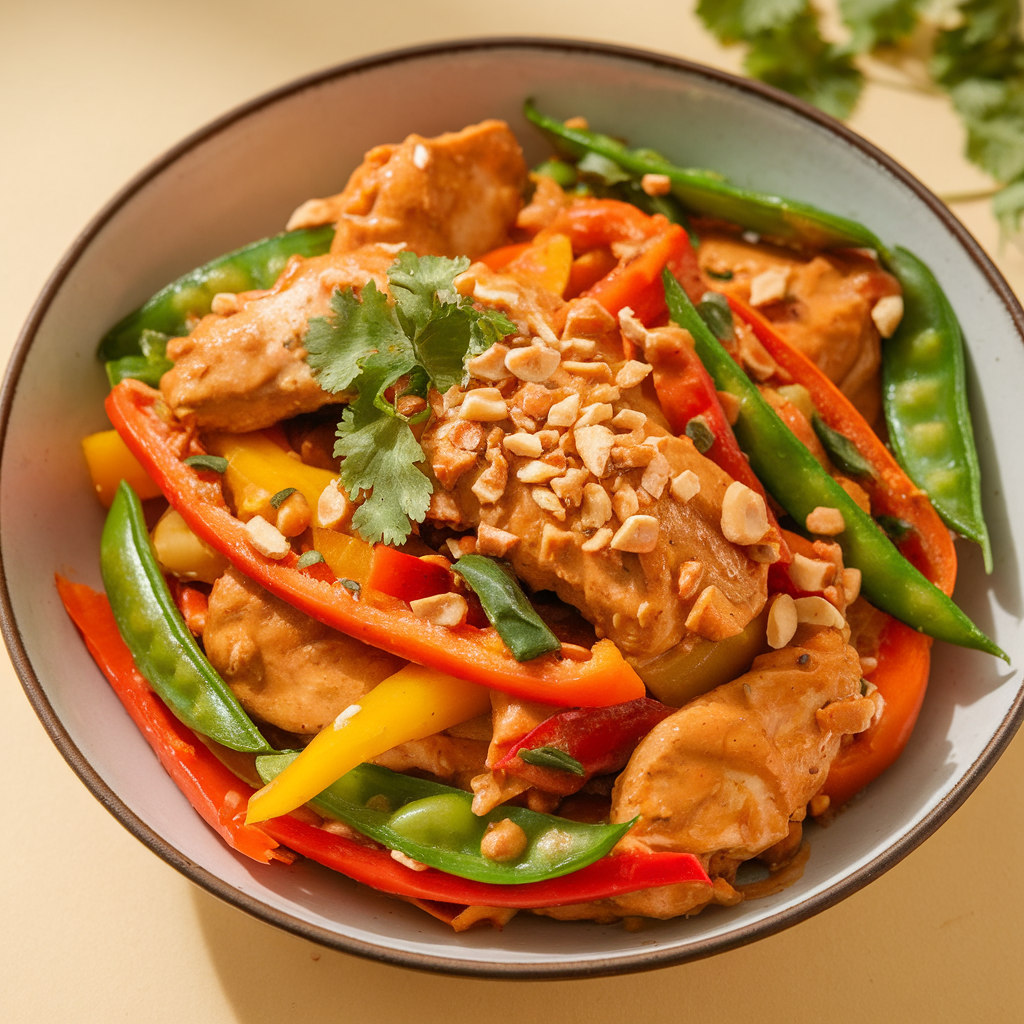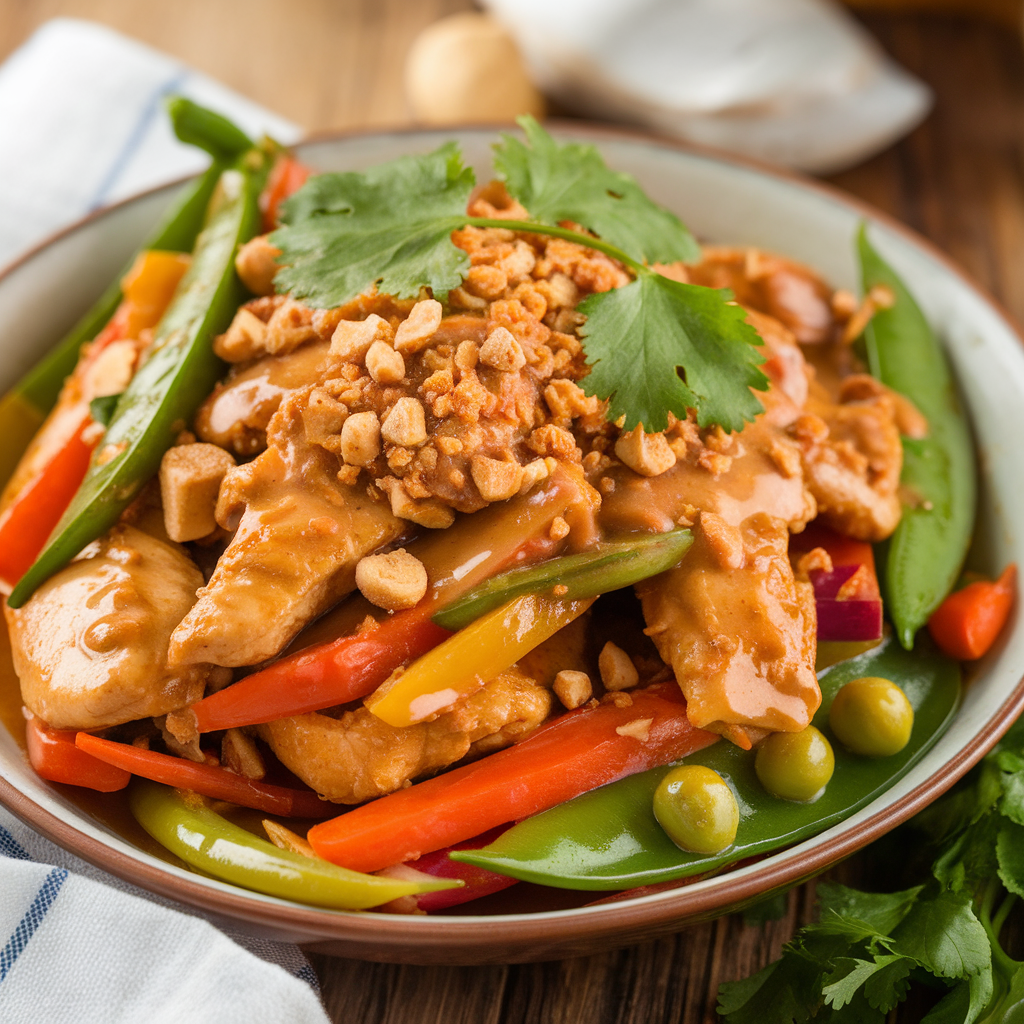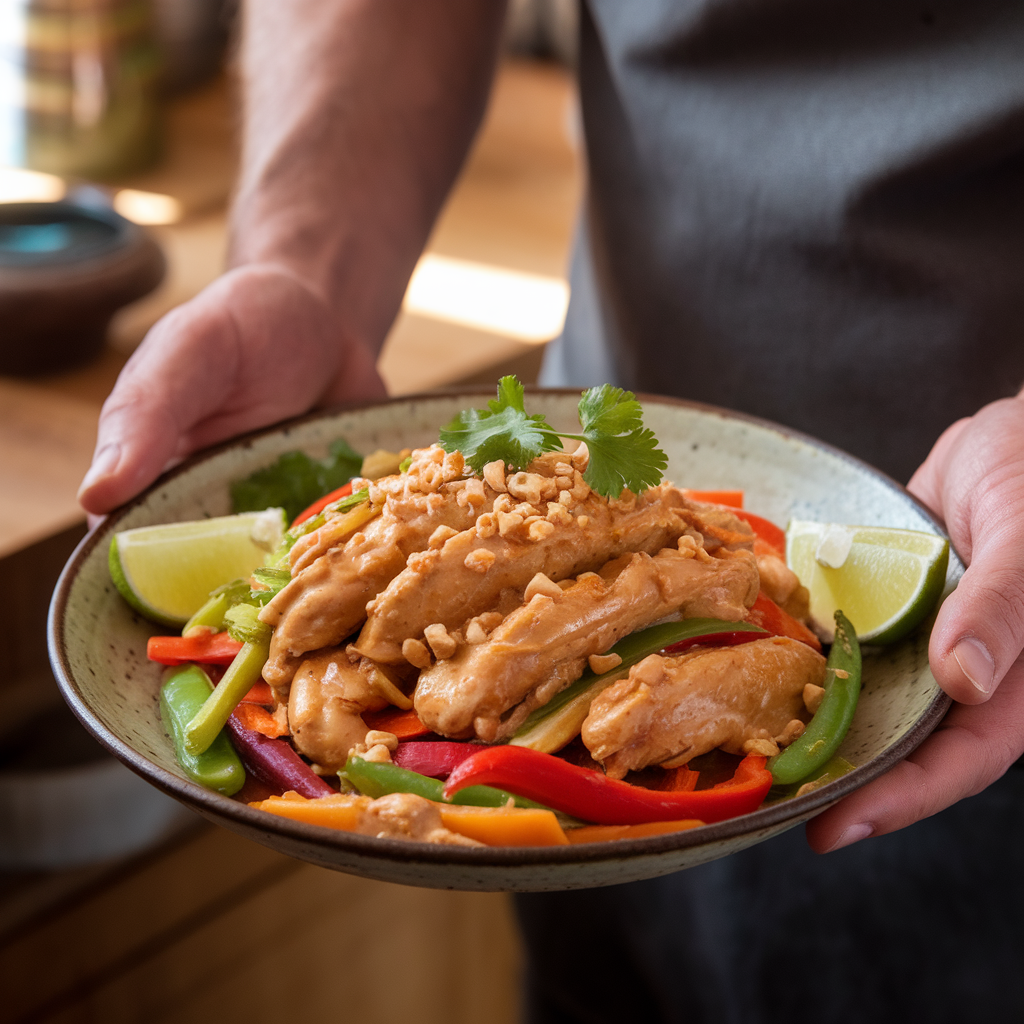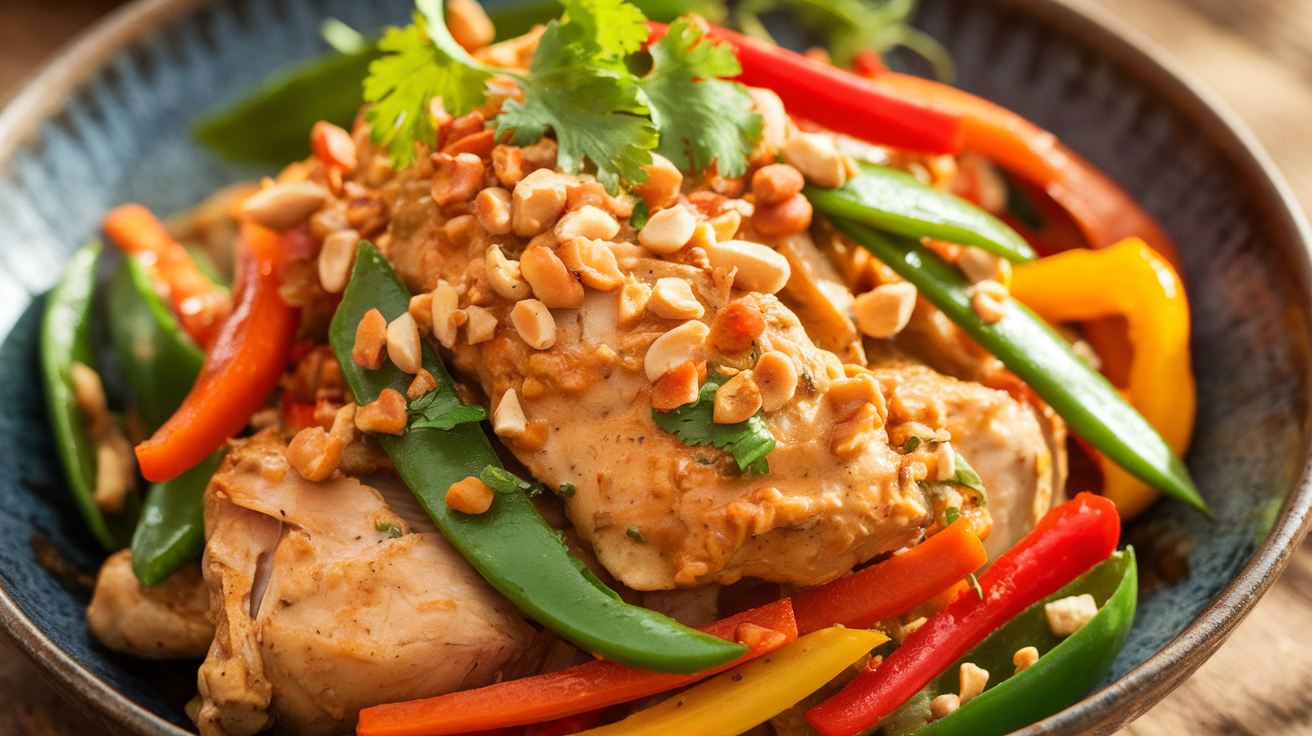If you’re craving a meal that’s bursting with flavors, packed with protein, and incredibly easy to make, look no further than Thai Peanut Chicken Stir-Fry. This dish combines tender chicken with a rich, tangy peanut sauce that hits all the right notes, making it a favorite among those who enjoy vibrant and savory meals. Whether you’re searching for tangy dinner recipes or a quick, hearty lunch, this Thai-inspired stir-fry fits the bill perfectly.
Packed with flavor, nutrition, and versatility, Thai Peanut Chicken Stir-Fry is an ideal dish for Thai food meal prep. The combination of peanut butter, lime, and soy sauce creates a delicious stir-fry sauce that elevates the chicken and vegetables, turning them into a well-balanced and satisfying meal. This recipe can be made in just under 30 minutes, making it a perfect choice for busy weekdays. Additionally, it can be easily adapted to your dietary preferences, whether you prefer it with rice, noodles, or a fresh vegetable base.
In this article, we will explore how to make a delicious Healthy Peanut Chicken dish, perfect for dinner or lunch. We’ll also cover variations and tips for creating a Thai Peanut Stir Fry Sauce, how to incorporate noodles for an extra hearty meal, and suggestions for Instapot Thai Peanut Chicken. Get ready to dive into a world of rich, nutty, and tangy flavors that will leave your taste buds dancing with joy.
Why Thai Peanut Chicken Stir-Fry is Perfect for Dinner and Lunch
Before we get into the recipe, let’s take a moment to explore why Peanut Lime Chicken with Noodles is such an excellent choice for both tangy dinner recipes e easy hearty lunch ideas. This meal is not only quick and easy to prepare but also offers a well-balanced combination of protein, healthy fats, and veggies. With just a few simple ingredients, you can create a dish that’s both satisfying and nutritious.
- Quick and Easy to Prepare: Thai Peanut Chicken Stir-Fry can be made in under 30 minutes, making it perfect for a busy dinner or a quick lunch. Whether you are a beginner or an experienced cook, this recipe is foolproof and requires minimal cooking skills.
- Nutrientes-Embaladas: The chicken provides lean protein, the peanut sauce offers healthy fats, and the vegetables add fiber and essential vitamins and minerals. If you serve this with rice or noodles, you’re also adding complex carbs that provide long-lasting energy.
- Personalizável: You can adjust this dish based on your dietary preferences and what ingredients you have on hand. Want to make it gluten-free? Simply swap soy sauce for tamari. Need a vegetarian option? Use tofu or tempeh instead of chicken. Whether you’re meal prepping for the week or making a quick dinner, Thai Peanut Stir-Fry Sauce can be customized to suit your needs.
- Delicious and Flavorful: The peanut sauce, made from peanut butter, soy sauce, lime juice, and a touch of sweetness, creates a creamy and tangy base that envelops the chicken and vegetables. The lime adds a refreshing twist, while the peanuts bring a lovely crunch and additional depth of flavor.

Key Ingredients for Thai Peanut Chicken Stir-Fry
To create this amazing dish, you’ll need the following ingredients:
- Chicken Breast or Thighs: Chicken is the perfect protein choice for this dish as it soaks up the flavors of the peanut sauce and cooks quickly. You can also substitute chicken with tofu, shrimp, or even beef for variation.
- Legumes: Traditional stir-fries feature a variety of fresh vegetables like bell peppers, carrots, broccoli, and snap peas. These vegetables add texture, color, and nutrition to the dish.
- Manteiga De Amendoim: The base of the sauce, creamy peanut butter creates the perfect consistency for stir-frying and adds richness to the dish.
- Soy Sauce or Tamari: This provides the salty, umami flavor that balances the richness of the peanut butter. Tamari is a great gluten-free alternative to soy sauce.
- Lime Juice: The tangy citrus flavor of lime juice helps cut through the richness of the peanut butter and adds a refreshing twist to the dish.
- O alho e o Gengibre: These aromatics add a depth of flavor and a hint of spice, making the sauce even more complex and savory.
- Mel ou Xarope de Bordo: A touch of sweetness is essential to balance the savory, salty, and tangy elements of the sauce. Honey works best for a classic Thai-inspired flavor, but maple syrup is a great alternative for a vegan option.
- O Óleo De Gergelim: For stir-frying, sesame oil is an excellent choice as it imparts a nutty flavor and high heat tolerance, making it perfect for this recipe.
- Rice or Noodles (Optional): While you can keep this dish low-carb by serving it with just vegetables, adding rice or noodles will turn it into a more hearty meal. Brown rice or cauliflower rice are good low-carb options.
- Peanuts: Crushed peanuts are used as a garnish for added crunch and texture. They also enhance the peanut flavor and make the dish more satisfying.
Step-by-Step Guide: How to Make Thai Peanut Chicken Stir-Fry
Now that you have all the ingredients, it’s time to dive into preparing this flavorful and nutritious meal. Here’s a step-by-step guide to making Peanut Lime Chicken with Noodles:
Step 1: Prepare the Chicken and Vegetables
Start by cutting your chicken breast or thighs into bite-sized pieces. Season with salt and pepper. Next, chop the vegetables — bell peppers, carrots, and broccoli work well, but you can also add other vegetables like mushrooms, zucchini, or snap peas.

Step 2: Make the Thai Peanut Stir-Fry Sauce
In a bowl, whisk together the peanut butter, soy sauce (or tamari), lime juice, garlic, ginger, honey (or maple syrup), and sesame oil. If the sauce is too thick, you can add a little bit of water or chicken broth to thin it out until it reaches your desired consistency. Set the sauce aside.
Step 3: Stir-Fry the Chicken
Heat a tablespoon of sesame oil in a large pan or wok over medium-high heat. Add the chicken pieces and cook until golden brown and fully cooked, about 6-8 minutes. Once cooked, remove the chicken from the pan and set it aside.
Step 4: Cook the Vegetables
In the same pan, add another tablespoon of sesame oil if needed and stir-fry the vegetables. Start with the harder vegetables like carrots and broccoli, cooking for about 4-5 minutes. Then, add the bell peppers and cook for an additional 2-3 minutes, until the vegetables are tender but still crisp.
Step 5: Combine Chicken, Vegetables, and Sauce
Return the cooked chicken to the pan with the vegetables. Pour the peanut sauce over the chicken and vegetables, stirring to coat everything evenly. Let it simmer for a couple of minutes to allow the flavors to meld together.
Step 6: Serve and Garnish
Serve the stir-fry over rice, noodles, or cauliflower rice if desired. Garnish with crushed peanuts, a drizzle of extra lime juice, and fresh cilantro for added flavor and a touch of freshness. Enjoy your Healthy Peanut Chicken stir-fry!
Variations of Thai Peanut Chicken Stir-Fry
While this Thai Peanut Stir-Fry Sauce is perfect on its own, you can get creative and make variations to suit your tastes or dietary needs:

- Instapot Thai Peanut Chicken: If you’re pressed for time, you can easily make this dish in your Instant Pot. Simply sauté the chicken in the pot, then add the vegetables and peanut sauce. Pressure cook for 10-12 minutes, and you’ll have a tender and flavorful dish in no time.
- Vegetarian Thai Peanut Stir-Fry: Swap the chicken for tofu or tempeh for a vegetarian version of this stir-fry. Tofu soaks up the peanut sauce beautifully and provides a satisfying texture.
- Peanut Lime Chicken With Noodles: To make this dish even heartier, serve the stir-fry over noodles. You can use whole wheat noodles, rice noodles, or even zucchini noodles for a low-carb option.
- Spicy Thai Peanut Stir-Fry: Add chili flakes, sriracha, or fresh chopped chili peppers to the peanut sauce for an extra kick of heat. Adjust the spice level to your taste.
Health Benefits of Thai Peanut Chicken Stir-Fry
Not only is this dish delicious, but it also provides several health benefits:
- Alta em Proteína: Chicken is an excellent source of lean protein, which is essential for muscle repair and growth. Protein also helps keep you feeling full for longer periods.
- Embalado com Gorduras Saudáveis: Peanut butter and sesame oil are rich in healthy fats, which support brain function, heart health, and overall well-being.
- Rich in Vitamins and Minerals: The vegetables in this stir-fry provide essential nutrients, including fiber, vitamin A, vitamin C, and potassium.
- Low-Carb Option: By serving the stir-fry over cauliflower rice or just vegetables, you can keep this meal low in carbs while still feeling full and satisfied.
- Rápido e Fácil: This dish is simple to make and doesn’t require hours of prep, making it a great option for a busy weeknight dinner or an easy hearty lunch idea.
Final Thoughts on Thai Peanut Chicken Stir-Fry
Thai Peanut Chicken Stir-Fry is the perfect meal for anyone looking for a quick, flavorful, and nutritious dinner or lunch. The creamy, tangy peanut sauce pairs perfectly with tender chicken and crisp vegetables, making it a satisfying meal that can easily be customized to fit your needs. Whether you’re making it in the Instapot, serving it with noodles, or keeping it light with just vegetables, this dish is sure to become a favorite in your recipe rotation.
With its blend of savory, sweet, and tangy flavors, this stir-fry is a great example of Thai food meal prep that’s not only delicious but also healthy. Enjoy it for a low-carb meal idea, a hearty lunch, or even a tangy dinner recipe that will impress your family or guests. The combination of peanut lime chicken and the vibrant stir-fry sauce is a true delight that will leave you coming back for more!


